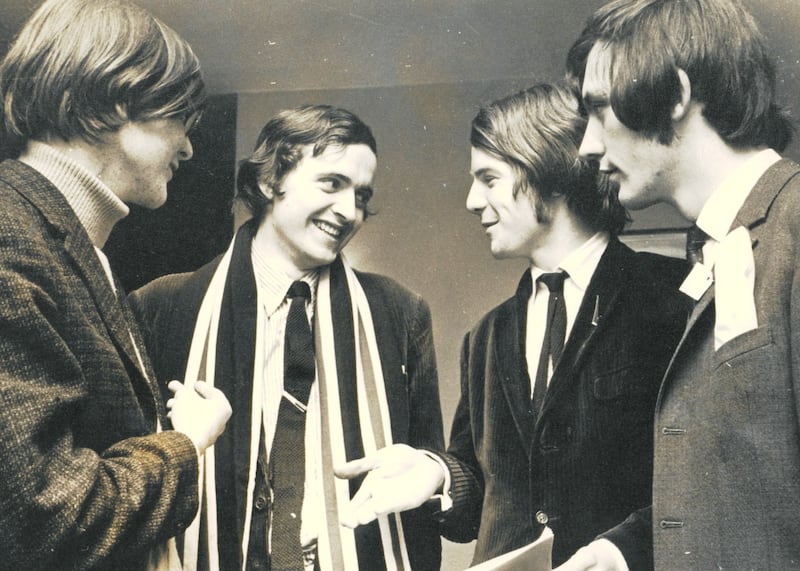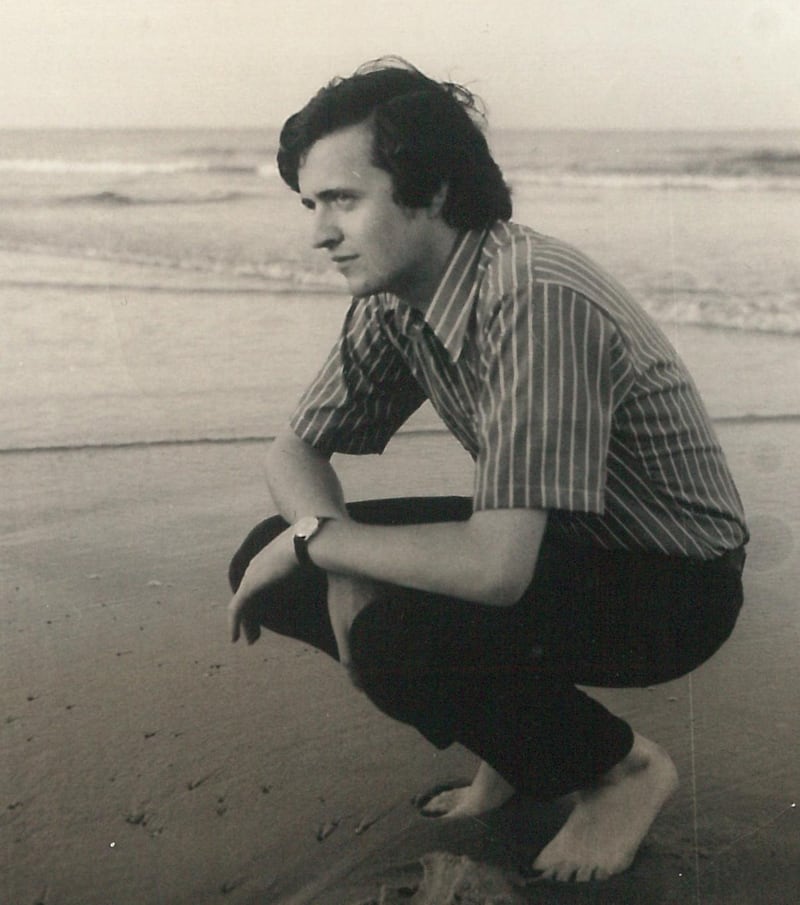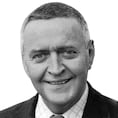Born in Dublin in 1950, Frank McDonald grew up in Cabra. A groundbreaking Irish journalist who wrote several books on Dublin's built environment, he was environment editor of 'The Irish Times' until his retirement, in 2015. This is a personal account of his childhood and life as a young gay man in Dublin.
There were always books in our house, some borrowed for a couple of weeks from Phibsboro Library, where we were regulars. Our permanent collection included a very useful set of books with titles such as How to Write, Think and Speak Correctly and The Wonderful Story of the Human Body ("by a well-known physician"). It had a chapter at the end dealing with "Reproduction and Sex" and that's how we must have learned about the mechanics of it all, since our parents never really talked to us about it.
Sometimes, I think my parents despaired of me. I made my mother cry more than once, which is an awful thing to admit. She saw me as a difficult, stubborn teenager, and I thought it was probably her fault that I was gay, that she had made me that way. This was nonsense, of course.
Even at 10 I was getting crushes on other boys in my class, one of them in particular; his name was David, and I wanted to be with him all the time
As a child, I had always imagined following the conventional route of getting married and having children of my own. But even as young as 10, I was getting crushes on other boys in my class, one of them in particular; his name was David, and I wanted to be with him all the time. The magnet pulling me towards him and other boys was something innate, buried deep in my psyche, and I had no control over it.
I also noticed that I didn’t have much of an Adam’s apple but did have knocking knees, like girls, and I assumed that something had gone wrong, as most boys were bow-legged; maybe I was meant to be a girl after all.
Around the same time, I started biting my fingernails, which was probably a sign of my underlying anxiety about who or what I was; the only treatment available was a bitter-tasting liquid “polish” that had to be applied every day.
Later on, when I was 14, I “messed around” with a school friend. We shared a desk and used to play with each other during class and regularly in cinemas, usually the Carlton. But it was a furtive thing that the two of us didn’t really acknowledge to each other.
By then, I knew that I was taking the road less travelled, and still remember the first time it occurred to me, reading Robert Frost's poem The Road Not Taken in the library in Phibsboro.
But as this realisation dawned, I didn’t like it one bit because I feared that mine was going to be a lonely journey. There was a norm, and I was deviating from it. And with no role models at the time, I was navigating through uncharted territory, or so it seemed to me.
None of it was easy. Gripped by Catholic guilt, I hated the idea of being “queer” and wondered if there was a cure. It was my dark secret, something that could never be admitted to my family or friends.
Regularly, I would have to listen to boys at school telling jokes about “queers” without letting on that I was one of them; my face would flush with embarrassment as I feigned joining in the laughter. It was awful.
I began to imagine my brain as a series of compartments – rooms off a central corridor, as it were. So I would put the “homo thing” in one of these rooms and open the door to it every so often, but otherwise pretended that it didn’t exist.

MY BROTHER LIAM and I eventually shook off devotion to Catholicism in our late teens, giving up going to Mass on Sundays. But there was no way we could tell our parents then. So we would leave the house and cycle up to the Botanic Gardens in Glasnevin, armed with a packet of cigarettes, some lemonade and a copy of The Sunday Times, which became an absolute must-read after Harold Evans took over as editor in 1967 and started publishing crusading investigative journalism.
It was quite a while before our parents twigged that we were mitching from Mass. I had stopped going to Confession, because I found it increasingly strange to have to kneel in a dark box and tell my sins to some (perhaps pervy) priest.
In all her years as an agony aunt on radio, from 1963 to 1985, I don’t believe that Frankie Byrne ever read out a letter from a guy saying he was having problems with his boyfriend; it was all strictly heterosexual. Had there been one, I like to think I would have used that opportunity to talk to my mother about it. But there wasn’t, and I didn’t.
Just as there were no tapas bars or sushi counters in Dublin then, there were no gay discos either, which was a problem for those of us who were tentatively exploring alternatives. Homosexual acts were criminalised by the 1861 Offences Against the Person Act, and so the gay scene was largely underground, focused on parks and public toilets.
I discovered this netherworld after going into the “gents” on Infirmary Road, right beside the People’s Gardens, and a guy in the next cubicle inched his foot under the partition until it touched mine; we ended up having it off. It seems quite sordid in retrospect, but lots of gay guys were doing that sort of thing; “cottaging” was the Grindr of the era.
The gents on Burgh Quay and the underground facility on College Street were very busy, as was the last remaining Parisian-style pissoir at Capel Street bridge, erected for all the pious men going to the Eucharistic Congress in 1932.
All are long since gone. When the cottage-style loo in St Stephen’s Green closed down, one of its older habitués reputedly placed a bouquet of flowers outside it, on the railings.
One guy I met early on plied me with gin, vodka and whiskey before taking me, almost comatose, to a relatively remote part of the Phoenix Park and having his way with me
There were risks, of course. One guy I met early on plied me with gin, vodka and whiskey at the Mullingar House in Chapelizod, before taking me, almost comatose from all the hard liquor, to a relatively remote part of the Phoenix Park and having his way with me. He was what we called a “chicken butcher”, with a predilection for firm young flesh.
They weren’t all like that. The more civilised “tricks” included a middle-aged Dutch guy called Willem van Heerden, who had a fabulous flat on the west side of St Stephen’s Green in a building long since demolished; a gorgeous Swedish airline pilot called Jahn Wennerholm, who had a mews in Lad Lane and a strong weakness for younger guys; a student from Ghana doing medicine at the Royal College of Surgeons who lived in Leinster Road; and an elderly man who had a bedsit on Holles Street.
That was one of the good things about the “gay scene”, I suppose – it was both ageless and classless; you could meet guys from any walk of life.
The trick I remember most was a well-spoken academic in his mid-30s who called himself “Martin” and was otherwise known as “Minty” because of his practice of giving Polo mints to the boys he picked up on Burgh Quay and other places, to freshen their mouths for French kissing.
When I had just turned 17, I met him in the toilets on College Street, and he whisked me off in his car to the TCD botanic gardens on Lansdowne Road, where the Berkeley Court Hotel was later built. For some reason, he had the keys to this little kingdom and used it regularly for trysts in one of the glasshouses, lying down with boys on a car rug between the potting racks. He took me there at least twice, and to one of the more private bathrooms in Trinity College on another occasion.
“Martin” passed me on to “Alan”, a blond-haired English postgraduate student in Trinity, who was also kind and gentle. The names were all phoney – I didn’t use my real name either, calling myself “Tom” – such was the fear of being blackmailed by someone or simply exposed as a “queer”.
Fast-forward nearly 30 years, and there I was watching a current-affairs programme on RTÉ when a strangely familiar figure appeared on the screen, being interrogated about his role in relation to a matter of serious public controversy.
Although he was wearing thick-framed glasses, probably as a partial disguise, I thought I knew him from somewhere. Suddenly, it hit me like a bolt from the blue: it was the man I had known as “Martin” who had keys to the long-lost botanic gardens in Ballsbridge. “Jesus, that’s Minty!” I remember saying out loud, even though I was alone at the time.

In 1972 Frank McDonald became a journalist for ‘The Irish Press’, working first as a subeditor and then as a news reporter
IN MARCH 1978 I reported on the funeral of Micheál MacLiammóir, co-founder of the Gate Theatre with his partner Hilton Edwards. The pair of them were English, both born in London, but they had embraced Ireland with such enthusiasm that MacLiammóir (originally Alfred Willmore) not only changed his name to a fictitious Irish one, but also became fluent in the Irish language.
I knew they were homosexuals, of course, and had seen MacLiammóir's marvellous one-man show The Importance of Being Oscar at the Gate more than once.
I had also heard the amusing story about how, shortly after the actor (who wore stage make-up all the time) was conferred with an honorary doctorate by the National University of Ireland, a PhD student doing a thesis on the Gate had telephoned their home on Harcourt Terrace, asking to speak to “Dr MacLiammóir”. Hilton Edwards, who hadn’t yet got his own honorary doctorate from Trinity, answered the phone.
“He’s not here,” the great producer told him. “Will Nurse Edwards do?”
MacLiammóir’s funeral, at University Church on St Stephen’s Green, was attended by the then president, Patrick Hillery, and I witnessed a very touching scene when he went over to commiserate with Edwards as the surviving member of Ireland’s best- known gay couple.
Here was the first citizen of our State, where homosexual acts were still illegal, doing the decent thing by paying his respects to them on behalf of us all.
The whole experience of leading a double life had left me emotionally, even psychically, scarred and it took me years to accept who and what I am
Probably due to years of denial about my own sexuality, I had none of that “Look at me!” confidence you’re meant to have going into a gay bar. It made my palms sweat with worry that someone I knew might see me in this compromising situation.
I felt so awkward about it that I never entered one of those bars alone; it was always with a friend or two. And even then, I was not much good at it. The whole experience of leading a double life had left me emotionally, even psychically, scarred and it took me years to accept who and what I am. I’m still working on that, to be frank.
Yes, that’s it. To be Frank, a more authentic version of myself. Some of my gay friends had started out as lovers, such as Alain Ficat, then deputy director of the Alliance Française in Dublin; or Gerard Cleary, a cute and caring dental student from Co Mayo, who went on to become a dentist in London.
Others were simply good friends, like the ever-entertaining Gary Quinlan, then first secretary of the Australian embassy in Dublin and later his country’s high commissioner in Singapore and permanent representative at the United Nations; Paul Murphy, a young surgeon from Galway, with a sense of humour that goes with the territory; and Ted Broderick, a bitchy civil servant in the Office of Public Works, who regularly hosted amusing dinner parties at his Oakley Court flat in Ranelagh. We would go to Dublin’s premier “gay-friendly” bar, Bartley Dunne’s on St Stephen’s Street (where the Grafton Plaza Hotel was built), or Rice’s on the corner of St Stephen’s Green and South King Street (later swallowed up by that ghastly shopping centre).
Another haunt was Duke Street, home to Tobin’s, with its 1950s cocktail-bar interior (now the Duke, with fake “snugs”), and the Bailey, which was a popular gathering place for more affluent gay guys on Saturday lunchtimes.

IN THE SUMMER OF 1975 I ran into a lovely French guy, Jean-Marc Gandit, who was in Dublin to brush up his English. At the time, he was working as a steward for Air Inter, the French internal airline, but he really wanted to be an opera tenor; I can still remember him singing an aria in the courtyard of an apartment building in Paris.
Always seeking more meaning in his life, Jean-Marc turned to Tibetan Buddhism, spent years in a prayer stall at the Dalai Lama’s retreat in Dharamshala, in the north of India, and is now lama (chief Buddhist monk) of Strasbourg with the adopted name of Tsultrim Guelek.
Then there was Alain Boschetti, a lovely French-Moroccan guy, who I met in London and continued corresponding with even after he had returned to Agadir to work as lycée teacher.
But my favourite was John, a tall trainee accountant, who I imagined as "the one" even though we had only just met. He was bright, good-looking and fun to be with. We had gone to see Cabaret on our first date and were delighted by that scene in which Michael York, looking more beautiful than ever, loses it over Liza Minnelli's infatuation with the rich amoral aristocrat played by Helmut Griem. "Oh, screw Maximilian!' he says. "I do," she replies, and then he darts back, with a knowing smile on his face, "So do I".
In Ireland, where one is forced to don a mask and pretend a lot, being 'gay' is especially difficult. It is not an easy prospect and hardly makes for the most fulfilling kind of life
Three weeks later, John stood me up. I had got tickets for Godspell [the musical] at the Olympia Theatre and was waiting for him to turn up. As the minutes ticked away, with no sign of him, I went to a phone box to call his flat and the line went dead. I rang again and the same thing happened. He had hung up on me, twice. I was devastated. Nobody had ever done anything like that to me.
Maybe John just didn’t like me any more. In a long angst-ridden letter I talked about how, in the “gay world”, it was hard to find people who might become really close: “Most relationships tend to be quite fragile and one is left with the alternative of seeking ‘casual’ associations, usually in squalid and revolting loos. But this is the sort of dilemma that goes with being ‘gay’. In Ireland, where one is forced to don a mask and pretend a lot, it is especially difficult. It is not an easy prospect and hardly makes for the most fulfilling kind of life.”
I didn’t hear from John for months. Eventually, he wrote me a letter apologising for “the rotten way in which I treated you during the summer”. He explained it by saying that “it was really a question of confused identity, which I hope I have sorted out since then,” and asked if I would like to go out for a drink some night, saying, “You can drop me a note. If not, I will understand.”
I can’t remember whether or not I accepted his belated invitation. Either way, it was the end of our all-too-brief affair.
BY THEN I HAD almost given up visiting relatives, mainly because some of them would keep asking whether I had found a "nice girlfriend" yet, which was irritating, when what I really wanted was a nice boyfriend, although I couldn't bring myself to admit that to them.
Gay discos were getting under way in Dublin, starting in a warehouse on Great Strand Street and moving on to a basement on the west side of Parnell Square, where a weekly event was run by the newly formed Irish Gay Rights Movement, (IGRM) led by Trinity lecturer David Norris. He was the first self-described homosexual to appear on Irish television in 1975, when he was interviewed by Áine O’Connor.
One Saturday night in September 1976, I was chatting to a friend, the diplomat Michael Hoey, outside the Royal College of Surgeons when a fresh-faced young fellow he already knew came along and joined in the conversation. His name was Eamon Slater, a telecoms technician then aged 22 (I was 26 at the time), and he was going to the IGRM disco on Parnell Square, so I said I might see him there later.
Which I did, and we have been together ever since.
This is an edited extract from Truly Frank: A Dublin Memoir, by Frank McDonald, published by Penguin





















